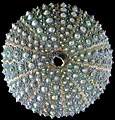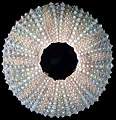The Echinoid Directory
Anthocidaris Lutken, 1864, p. 162, 165
| Diagnostic Features |
|
|---|---|
| Distribution | Miocene to Recent; Japan and China Sea. |
| Name gender | feminine |
| Type | Toxocidaris crassispina A. Agassiz, 1863, by original designation. |
| Species Included |
|
| Classification and/or Status |
|
| Remarks |
|



